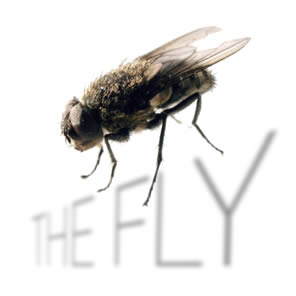The Fly
(flying insect)
common housefly, Musca domestica
Key features
Adults are 6 - 8 mm long. Wings span 13 - 15 mm.
The thorax is grey with four longitudinal dark stripes.
The fourth vein on the wing bends sharply forward,
Almost reaching the third vein. The sides of the abdomen are yellowish and may be transparent.
A central dark bans broadens at the back to cover the final abdominal segments. The pupa is about 6 mm long and may be yellow, brown or black.
The larva is a typical maggot. It undergoes larval molts, gradually increasing in size and changing color from white to cream.
Biology
A female fly becomes sexually mature one to two days emergence. Eggs are laid a few days after copulation. The adult flies live 1 - 3 months depending on temperature; during her lifetime the female ill produce 400 - 750 eggs. Eggs are laid in moist, fermenting or putrefying material such as excrement, rotting vegetable matter; especially that with a high protein content. Newly hatched larvae shun the light and tend to burrow into the food material. In fermenting material, larvae often seek zones of high temperature, s high as 45°C - 50°C. When mature the larvae leave the breeding site and seek a cooler environment, for example in soil. . At this stage wondering larvae may travel considerable distances and may become an accidental inclusion in commodities. The adult fly may travel up to 5 miles in search of suitable development sites. It is attracted by odors. The food requirements of adult flies are mainly for carbohydrates which are taken in liquid form having been dissolved by regurgitated digestive juices.
In common with other insects, development times are influenced by temperature, relative humidity, moisture content, quantity and quality of food. The following figures are therefore only a guide and show the hours spent at each stage of the life cycle.
Egg 0.3 - 2
Larvas 3.5 - 30+
Pupa 3 - 30+
Adult 30 - 90
Duration of the life cycle is 1 - 5 weeks. The average length of the cycle during the summer is 3 weeks. It is likely that flies over winter as slowly developing larvae in manure heaps and refuse.
Significance
Houseflies are potential vectors of a wide range of diseases such as dysentery, gastroenteritis and tuberculosis. They can also transmit intestinal worms. They move from filth to food indiscriminately and may therefore have pathogens from dirty to clean areas. Fly spotting is produced feeding and defecating.
Control
Good hygiene is essential. So as to limit breeding sites and food sources. Refuse should be stored in well sealed containers. Refuse tips should be covered with earth to a depth of at least 9 inches and then compacted. Fly screens and other proofing methods should be utilized. UV light stalls should be installed where appropriate. Fly traps with a bait attractant may prove useful in dealing with localized problems. Residual insecticides applied as surface treatments, dusts, lacquers and vapor strips may all have their uses depending on the extent and the site of the infestation. The application of the residual synthetic pyrethoids to areas where the flies are seen to congregate will help to alleviate the problem. It should be pointed out that the use of residual insecticides, particularly synthetic pyrethroids, in poultry units is not recommended, as it will almost certainly cause a very rapid development of insecticide resistance in the fly population.
The following points, relating specifically to fly control in animal units are based on the recommendation of the Pesticides Safety and Food.
The program of fly control should be based on a combination of bait products and space sprays. However, if the development of resistance of insecticides in fly populations is to be avoided then bait products containing the same active ingredient should not be employed continuously in a unit.
It is recommended that prior to a unit being stocked, baiting be carried out using an approves pain-on bait or granular bait.
Suspended cardboard 'bait stations' may be used in the pit to get increased cover and more efficient baiting.
The timing of subsequent baiting may be determined by larval or adult monitoring. When a second treatment is required the alternative product should be selected.
An alternative, or supplementary treatment to baiting is the use of space sprays. A ULV treatment is likely to give the most effective result. This should be used in both the pits and cage areas. I must stress that any space spray should be used no more frequently that once a week.
Whilst it is accepted that there may be a great deal of pressure to carry out treatments more frequently, the consequences of this would be the development of resistance in the fly population. Were this to a occur a situation could arise where none of the chemicals currently available will control the housefly populations.
.






